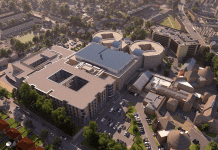We’ve been speaking about integrated security for a long time. If we’re serious about it then we need to start working more closely and much earlier in the design and planning process, says Stewart Liberatore, projects director at RWS
The threat we face around the world is multifaceted and ever-changing. The threat is not always physical, either – digital attacks can be just as damaging, such as the WannaCry malware that affected many NHS systems.
The planning, design and security sectors need to work together to produce a much more sophisticated and collaborative approach when it comes to protecting our buildings, infrastructure and the people within them.
We won’t be able to extinguish every threat, but we can do a much better job of mitigating them.
The end of silo working
Integrated security means we need to think of the bigger picture when it comes to the security of a building and people. That simply must mean more collaborative working much earlier in the process – security needs to be designed and planned into the fabric of a building, not added on later or retrospectively fitted.
The current approach to security in many buildings is not only costly, it’s also far less effective than a ground-up effort that’s been worked on by the designers, architects, engineers, security experts and planners.
For years, we have managed to protect our buildings, infrastructure and people with a mixture of security solutions that were often intelligent, but rarely part of a holistic system.
Our current way of working, whereby security is designed in at a later stage, means it is impossible to create an integrated solution. As Jasvir Gill, CEO of AlertEnterprise, said: “You can never be safe if you put three locks on one door and leave the other doors wide open”.
It sounds obvious, but it’s so easy to leave one of those doors open during a complicated design and build process. Getting security consultants to barricade that door further down the line is not ideal.
Security as a design issue
Making the shift to integrated security means design and planning teams sharing the responsibility with the security experts.
Security is a design issue that must be incorporated at the initial concept design phase. Traditionally, aesthetics have dominated the overall building design, with architects’ concern for the working environment being compromised by security provision and the security expert worrying about the lack of security provision at the concept phase.
We can no longer afford to have these factors competing with one another.
A simple solution we implement at RWS is to ensure we have a security expert engaged during the concept phase. He or she will then work closely with the design team to ensure security is woven into the fabric of the building. This ensures all teams involved will achieve the common goal of keeping tenants, workers and visitors safe.
Sadly, we are too often involved in projects where security (let alone integrated security) is thought about much later in the process to be most effective. It’s usually planned in, but at a point where it is much more complex to implement security changes and is much more expensive.
Good design can also encourage good security behaviour among building occupants – just one advantage of implementing security at the concept phase.
Good security doesn’t need to mean poor aesthetics either. In fact, some of the best integrated security solutions are those that aren’t obvious on street level. Security products should reflect good design in any case. Just because it’s a functional CCTV camera doesn’t mean it has to be ugly.
Beyond hardware
It goes without saying, really, that the later security consultation is left, the more likely an expensive, or even serious, security flaw will be discovered. Even if some security issues are discovered before construction starts, it still means a lot of architectural headaches as plans need to be changed to cater for new security measures.
Security is often a small percentage of the cost of any building project and the “returns” are only seen if a negative event is prevented. But that really overlooks the importance of proper security designs and measures.
The problem is our mindset. We see security as cost that prevents something that hasn’t happened yet. Further still, we see that security as just hardware – cameras, barriers, personnel, access control. But the truth is, as mentioned earlier, it should be firmly in the court of the design teams. Of course, the responsibility still needs to be shared – however, it’s important to bring a security consultant onboard as soon as possible. This means proper research and assessments can be carried out, allowing architects to design around the problem or incorporate technological solutions as part of it.
A simple example is traffic or crowd control whereby the road layout or walkway prevents direct access to a potential target – for example, forcing people or cars to take a longer, winding route, as opposed to a short straight one, immediately makes a target harder to access.
There are numerous examples like this but, ultimately, it’s up to security consultants/firms, architects, planners and other personnel to make integrated security as important as the building itself. After all, without protecting the critical structures, data centres or the people within it, a building is next to useless anyway.
Stewart Liberatore
Projects Director
RWS
Tel: +44 (0)1733 351136

















